A piece of heaven on earth so rare,
Munsiyari beckons with a tranquil air!
These were the exact thoughts that crossed my mind after a long Delhi to Munsiyari road trip.
When we reached this hidden gem in Uttarakhand, I was completely amazed. It felt like stepping back in time, untouched and unchanged.
That’s what makes this place so special – it has a rustic, vintage charm, wrapped in the beauty of snow-capped peaks and sunsets painted in warm orange hues.

- Save

- Save
Munsiyari is a small beautiful qaint town, nestled in the Pithoragarh district of Uttarakhand.
We embarked on an epic 7 days Delhi to Munsiyari road trip and in this blog, we’ll take you along every step of our journey, from the scenic drives to the unforgettable moments we experienced along the way.
Table of Contents
TogglePlanning a Delhi to Munsiyari Roadtrip? Here’s Everything You Need to Know
Munsiyari is one of the most affordable hill stations we’ve visited, making it a great destination for budget travelers. For our trip, we spent approximately: 7500 INR on accommodation, 2500 INR on meals and 500 INR miscellaneous over the course of three nights.
- Best Time to Visit Munsiyari: The ideal time to visit Munsiyari is from April to June when the town is lush and green, perfect for trekking and exploring nature. If you’re a snow lover, the months from December to February are best , as Munsiyari is beautifully covered in snow during this time.
- Limited Accommodations: While Munsiyari is gaining popularity, it’s still a small town with basic accommodation options. Hotels and homestays are simple, so if you’re traveling with family or kids, it’s a good idea to bring all your essentials.Booking your stay in advance, especially during peak season, is highly recommended to avoid any inconvenience.
- Road Conditions: The journey to Munsiyari involves some tough terrain, (be prepared for winding roads and narrow paths) so it’s important to drive carefully or hire a local driver if you’re not comfortable with hilly roads.
- Be Ready for Remote Locations: Munsiyari is quite isolated, so don’t expect bustling markets or a wide range of touristy attractions. It’s all about soaking in nature’s beauty and enjoying the peaceful environment.
- Carry Cash: Not all places accept digital payments or UPI, so its better to carry enough cash.
- Network Connectivity: Jio network works well in Munsiyari, However, keep in mind that connectivity may be limited in some remote areas,so download offline maps.
- Fuel Availability: If you’re doing a road trip to Munsiyari, make sure to fill up your fuel tank before reaching. Fuel availability in Munsiyari is limited, and there may be some time restrictions on when you can refuel, so it’s best to be prepared and plan accordingly.
- Snowfall Precaution: For visitors planning to visit Munsiyari during snowfall, it’s highly recommended to have a 4×4 vehicle. The roads can get slippery and challenging, especially in the winter months, so a 4×4 will ensure a safer journey.
- Helicopter Service from Haldwani to Munsiyari: For those looking to save time, a helicopter service has started operating from Haldwani to Munsiyari, with a fare of 4000 INR per person. It’s a great option for a quick and scenic journey. You can check out the Heritage Aviation’s official page for booking inquiries and more details.
- If you are planning a Snow trip like us, keep in mind that temperature in Munsiyari can drop drastically, so it’s crucial to be well-prepared for the cold. For some essential packing tips to stay warm and comfortable, be sure to read : Our Essential Winter Packing List: Lessons Learned from Frozen Trips

- Save
Our Road Trip From Delhi to Munsiyari Via Pithoragarh
The Delhi to Munsiyari distance is approximately 630 kilometers, which takes around 15 to 17 hours by road. We started our trip from Delhi at 6 AM, making our way to Pithoragarh via Tanakpur for a brief layover. Well, the roads from Tanakpur to Pithoragarh were quite uneasy, with sharp bends that can leave you feeling nauseous, so if you’re prone to motion sickness, be prepared. It’s best to avoid using your phone during the drive and carry chewing gum or candies to help with the discomfort.
The drive is around 12 hours, so it’s a good idea to pack some protein bars and snacks to keep you energized along the way.
On the stretch from Tanakpur to Champawat, we passed through a small town called Belkhet, and the landscapes there were gorgeous! As you begin to ascend the hills, within just 30 minutes, you’ll come across Tulsi Dhaba – stop by if you’re already craving a local pahadi meal.
As we entered Pithoragarh, I was completely blown away by the grandeur of the place. It felt like stepping into a different world – not touristy at all but bustling with locals.

- Save

- Save
Since we were taking our time, we decided to stay for two days in Pithoragarh to explore the local market and the mountains. The market at Gandhi Chowk is a must-visit. It’s full of vibrant fruit vendors and offers plenty of shopping options, especially for winter wear. The prices are reasonable, and some shops have a great variety of woolens.
We also visited Vardhani Viewpoint, where the ticket is just ₹10, and the 360° views of Pithoragarh are breathtaking. There’s a small restaurant at the viewpoint, so you can grab a bite and enjoy the amazing scenery while you relax.
For food, we highly recommend trying the momos at Momo Mania – they’re a local favourite! Meghana Café (Café on the rocks) offers great vibes and good food with a view. If you’re a fan of non-vegetarian dishes, don’t miss Nagarkoti Restaurant, where you can enjoy some delicious options.
For those with a sweet tooth, Satkar Sweets and Himalayan Bakers offer tasty chaat and a variety of sweets that will definitely satisfy your cravings.
Other places to explore in Pithoragarh includes the serene Khamakhya Temple, the Mostamanu Temple, both offering a tranquil experience. Don’t miss the Pithoragarh Fort, which holds great historical significance.
We chose to stay at Aranya Wood Resort in Chandak, Pithoragarh, which turned out to be a peaceful retreat, just the kind of quiet escape we love. The stay was comfortable and cozy, perfect for unwinding after a long journey.
If you’re looking for other options, MJ Hotel and Resort in Lohaghat, The Chandak Bunglow, Sun and Water resort can be great alternatives too.

- Save

- Save
Drive From Pithoragarh to Munsiyari
There are two ways to cover the Pithoragarh to Munsiyari distance: via Thal and via Jauljibhi. While the Thal route is the shorter of the two, the Jauljibhi route is far more scenic and filled with natural wonders. We took the later one!
As we left for Munsiyari, oh my God, it started raining, and the beauty was just unreal. The mountains were covered in fog, and the forests seemed to melt into the mist. The view shifted so quickly – one moment we were enjoying sunny skies, and the next, the mountains were completely enveloped in mist.
I kept saying, “Wow, wow!” over and over as we drove from Pithoragarh to Munsiyari via the Jauljibhi Road. It was like stepping into a dream.
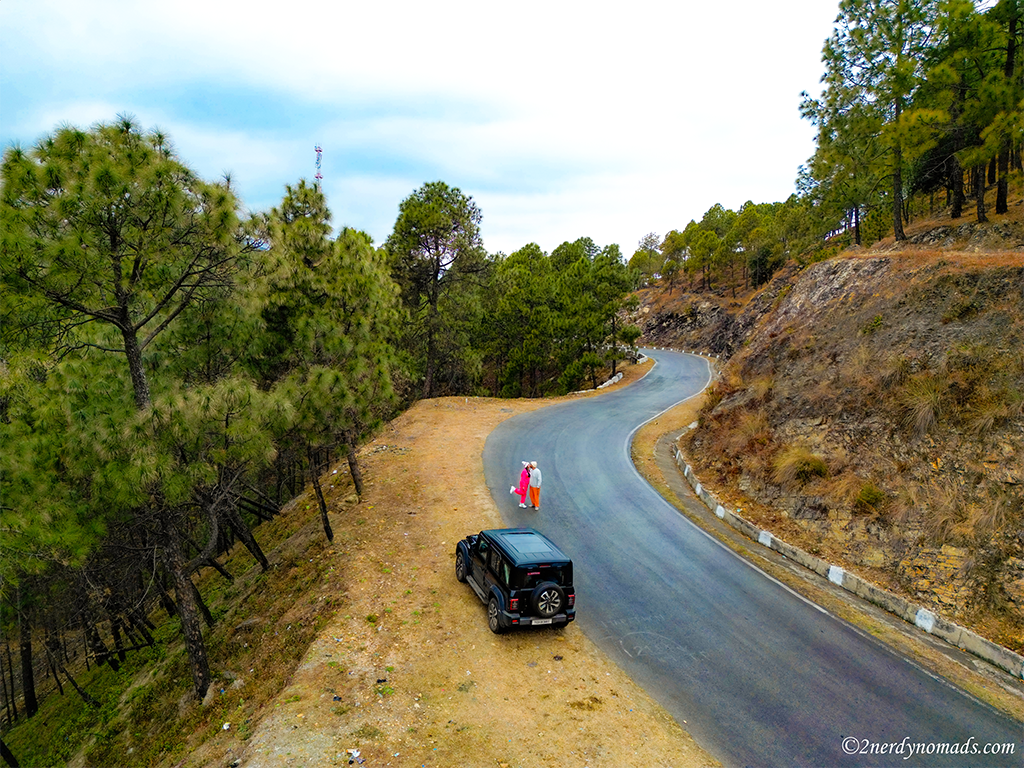
- Save
At first, it was just a light drizzle, but then it started raining heavily, and that’s when the mountains truly transformed. They turned into misty peaks, with fog swirling around every corner.
At every turn, you’d feel the urge to stop, either to capture the beauty or just to soak it all in. The journey was filled with countless waterfalls cascading down the mountainsides.
The grandeur of the mountains was beyond words – they were massive, towering, and unlike anything I’ve ever seen before. It felt like being surrounded by giants.
As we continued our journey, we crossed two beautiful rivers – Gori Ganga and Kali Ganga. Gori Ganga flows from the Milam Glacier and follows the route from Munsiyari to Jauljibhi. While Kali Ganga (also known as Sarda river) acts as a natural border between India and Nepal. Yes! you read it right. You can see the blend of Indian and Nepali terrains. It’s a humbling experience to witness!
Consider making a pitstop at the hot water springs in Madkot, located approximately 22 km before Munsiyari. These natural hot springs are a hidden gem, known for their soothing and therapeutic properties. You might even spot locals enjoying a relaxing bath here.

- Save

- Save
Around 4:23 PM, we got our first sighting of snowfall! By the time we made it to Munsiyari, it was already past 6 PM – dark and incredibly cold. We checked into our hotel, had a warm dinner, and decided to call it a day. But the next morning, when we woke up, we couldn’t believe our eyes.

- Save
Top Things to do in Munsiyari:
We would suggest staying at least 3 nights in Munsiyari (keeping extra days if you wish to trek).
Khaliya Top Trek
The Khaliya Top Trek is one of the most popular treks in Munsiyari, offering panoramic views of the snow-capped Panchachuli Peaks, but it’s definitely not beginner-friendly. The trail is quite steep and paved with stones, making it a challenging climb.
The best way to do this trek is to start in the afternoon around 2 PM and hike about 3 km to the KMVN guest house, where you can stay overnight. The next morning, you can continue the remaining 2 km to the top to catch the breathtaking sunrise.
The entry fee to Khaliya Top is just 20 INR , but be prepared for the cold and the demanding trail. Proper trekking gear and warm clothing are essential to enjoy this unforgettable experience.
Village Life at Darkot:
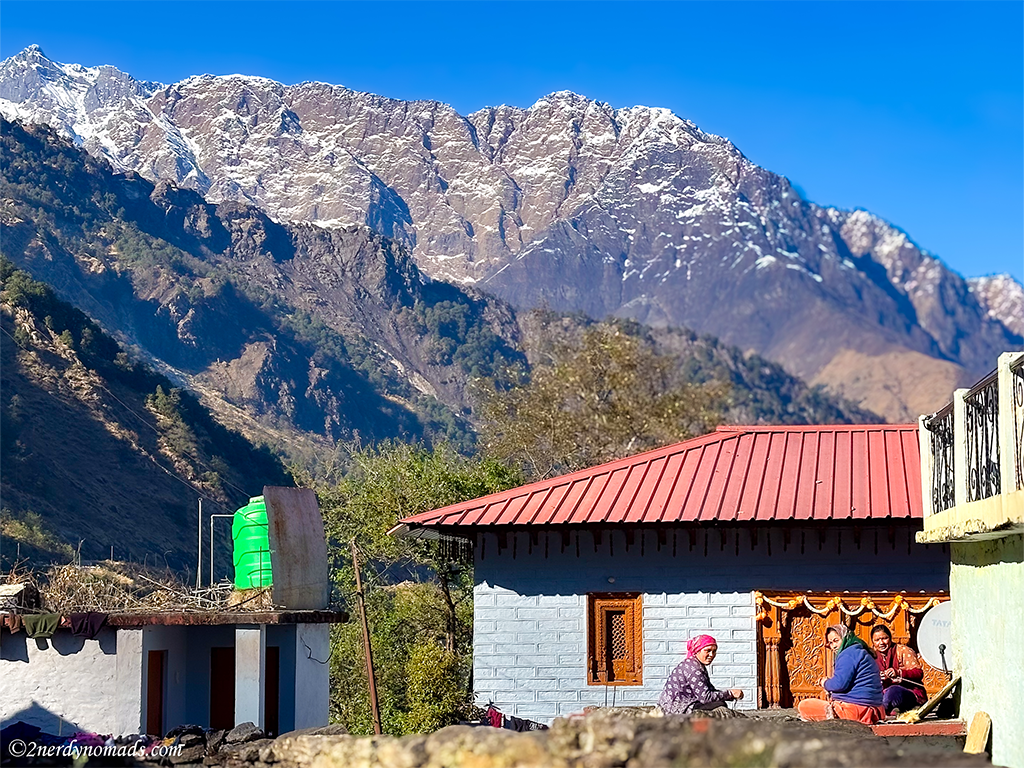
- Save
If you want to truly experience the charm of hill life, we highly recommend adding Darkot Village to your Munsiyari trip. The drive to Darkot is scenic, with mesmerizing views of the five snow-capped peaks accompanying you throughout the journey. It’s undoubtedly one of the most picturesque drives we’ve ever taken.
Darkot is a beautiful little hamlet filled with warm and friendly people. It’s a hub for traditional handicrafts, where locals create exquisite handwoven items. What we loved most was the relaxed and genuine vibe – no one was pushy about selling their crafts. They are happy to show you their work, but buying is entirely upto you.

- Save
We had the pleasure of meeting Geeta aunty and her family at Darkot Village who welcomed us with such warmth. She not only served us tea but also treated us to a local dish made of wheat called Kukla. It’s somewhat like noodles and is typically eaten for breakfast with chapatis. The taste was unique and delightful, and we loved every bite!
Talking to her was such a wholesome experience as we exchanged stories about our cultures. She also showed us the handmade woolen items like gloves and socks that the villagers create with so much care.
The simplicity of life here is inspiring. It’s a small village, but the experience of seeing locals go about their daily lives with such calm and patience was truly amazing.
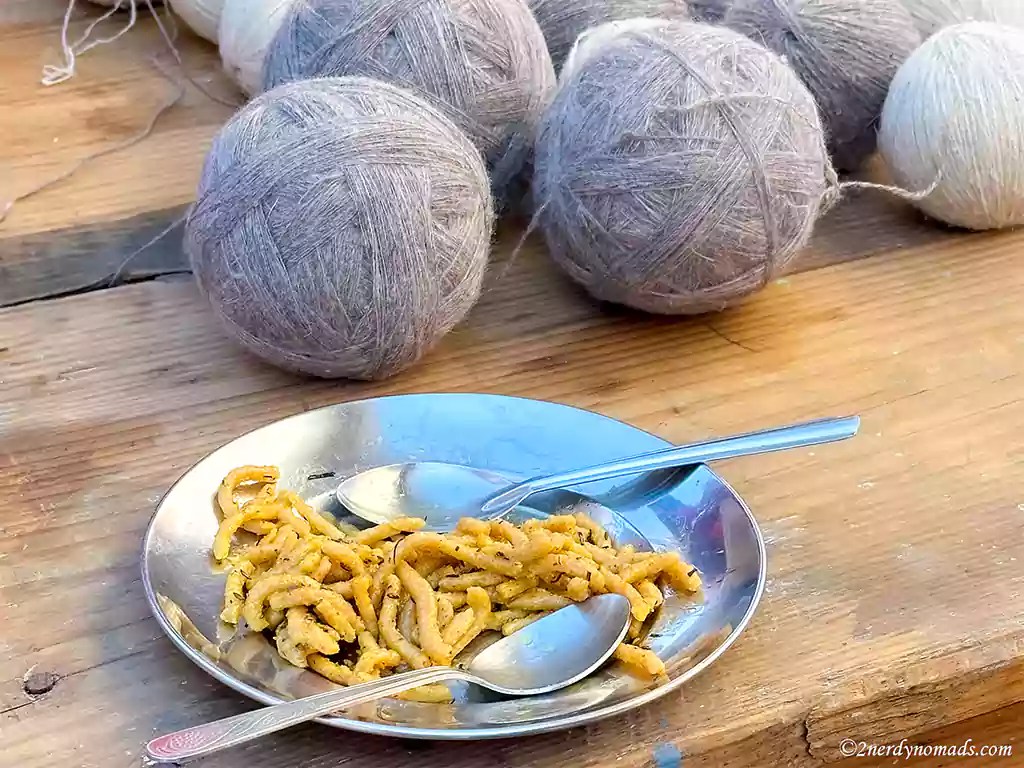
- Save

- Save
Tribal Heritage Museum:
Another fascinating thing to do in Munsiyari, especially if you’re interested in the history and culture of the Kumaon region, is visiting the Tribal Heritage Museum.
Established in 2000, this small, privately-owned museum offers a glimpse into the rich history, culture, traditions, and lifestyle of the Bhotia people – an ethno-linguistic group living in the upper Himalayan valleys of the Kumaon and Garhwal regions of Uttarakhand.
It’s incredibly well-preserved and offers an immersive experience with an audio guide to walk you through the exhibits. The museum was curated and maintained by the Dr. Sher Singh Pangte, a history professor who dedicated 15 years of his life collecting artifacts from the villages. (Ah! so fascinating)
The Tribal Heritage Museum is located at the residence of Mr. Pangtey and is easily accessible via Google Maps. There’s a nominal entry fee of ₹30. However, photography and videography are not permitted, so you’ll have to soak in the cultural richness with your eyes and memory.
Nanda Devi Temple:
The Nanda Devi Temple is one of the oldest and most revered temples in Uttarakhand, dedicated to Goddess Nanda. It holds significant importance in Hindu religion and is a must-visit when in Munsiyari.
Located just 3 km from Munsiyari on the Munsiyari-Madkot route, you can easily reach it with a short 200-meter trek from the road. The complex charges a small fee of 30 INR.
As you step into the temple premises, you’ll be enveloped in a divine atmosphere, with the stunning Himalayan peaks surrounding the area. It’s a place of absolute peace, where you can seek blessings while treating your eyes to the beautiful mountain views.
I am sure, the calmness of the place will make you want to stay longer.

- Save
Lichen Park:
Lichen Park is a must-visit for nature enthusiasts and those interested in unique ecosystems. Munsiyari is home to India’s first Lichen Park, which developed in 2020.
Lichen, known locally as Jhula or Patthar ke Phool, are fascinating organisms that grow in the cleanest air and are typically found on tree barks, rocks, walls, gravestones, roofs, and even soil.
We were pleasantly surprised to learn that lichen is a key ingredient in the famous Hyderabadi Biryani!( Woahh!)
Uttarakhand is home to over 600 species of lichen, with Munsiyari, Pithoragarh, and neighboring towns being prime spots to see these unique growths.
Thamri Kund Trek:
The Thamri Kund Trek is a short yet rewarding hike in Munsiyari, a hidden gem, overlooked by many tourists (easy and beginner friendly).
Thamri Kund is a natural lake, surrounded by the beautiful paper trees. The lake is also home to a population of musk deer that come to drink its refreshing waters. Locals consider the lake sacred, believing it blesses them with rain during times of need.
The trek to Thamri Kund is a 3 km journey from the Hanuman Temple, taking you through lush forests and offering spectacular views of Panchachuli Peaks along the way.
Since the trek can take up most of your day, it’s a good idea to keep an extra day in your itinerary.

- Save
Secret View Point:
The “Secret Viewpoint” might sound like a mysterious name, but it’s actually what you’ll find on Google Maps- though the spot is originally called Dil Tal. A short hike through flat meadows leads you to this hidden gem, where you can witness a magical sunset over the stunning Panchachuli peaks.
You can easily spend hours soaking in the breathtaking views and enjoying the tranquil surroundings.
Do keep in mind that it can get quite windy at the viewpoint, so make sure to layer up properly before heading there.
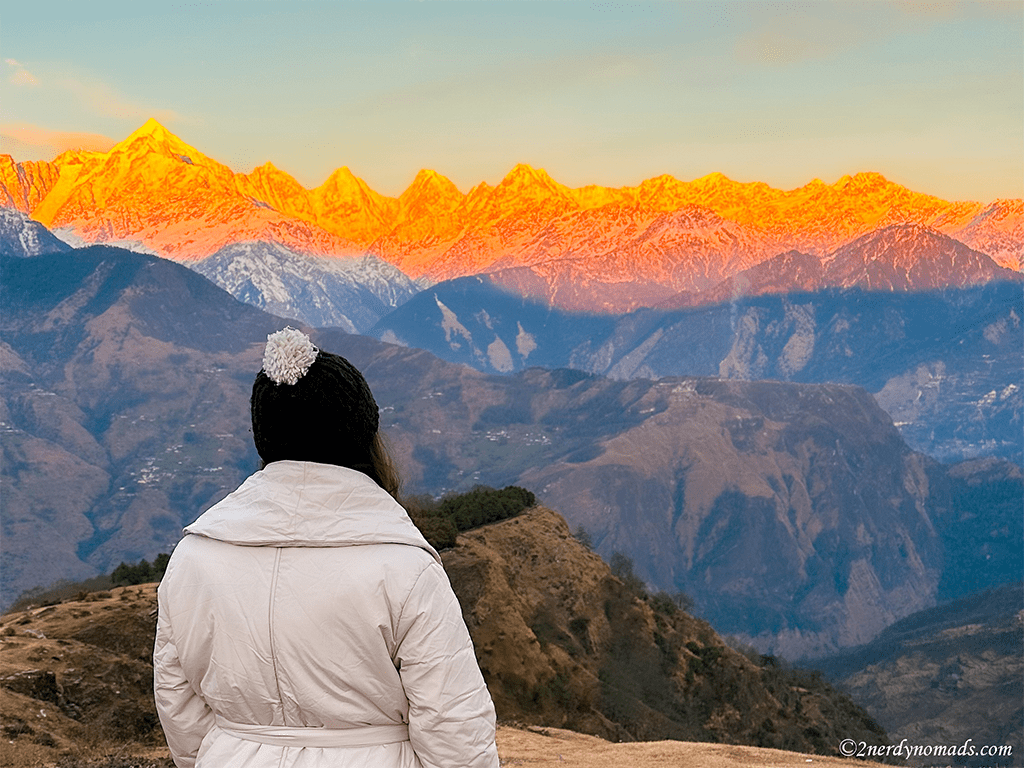
- Save
Birthi Falls:
Reserve a day for visiting Birthi Falls, located 33 km from Munsiyari. The drive to Birthi is filled with stunning landscapes. Once you reach the falls, you’ll be greeted by the breathtaking sight of the 126-meter cascading waterfall.
The trek to the falls is a leisurely 10-minute hike, perfect for taking in the views, capturing some photos, and enjoying a cup of tea. The area is managed by the local villagers, who charge a nominal fee of just ₹20.
Afterward, we stopped by the Birthi Restaurant, where we had a warm, comforting plate of pahadi Rajma rice and tea -a perfect way to end the visit.
However, keep in mind that during winters, the falls may not be as intense, with water flow reduced. According to locals, the falls are at their most powerful during the monsoons, when the water flow is so strong that it can sometimes lead to road blockages.
So, plan your visit accordingly depending on the season and the kind of experience you’re looking for.
Where to Stay in Munsiyari?
While Munsiyari is becoming more popular, it remains a small town with basic accommodation options.
We stayed at Hotel Vijay Mount View, a pretty basic hotel, but the views were nothing short of luxurious. The hotel provided essentials like a heater, geyser, kettle, and warm blankets, which were particularly appreciated during the cold winter nights. We also had a few meals here, and the food quality was impressive. The location was perfect, and the service was quite good.
Other hotels in Munsiyari worth considering are Milam Inn (mid-budget), Neer Stays, Jayanti Mother Nature Homestays, and Matrachaya Homestay for a more local and cozy stay.
Pro tip: keep in mind that heaters in hotels may cost extra. It’s best to check with your hotel beforehand to avoid surprises!
Where to eat in Munsiyari ?
If you’re a fan of homely, wholesome food, Munsiyari will surely steal your heart. The town is dotted with small local eateries offering simple, delicious meals of dal, roti, and sabzi, often prepared with love by the locals.
We highly recommend Apna Bhojanalya, a rustic spot run by the warm-hearted Yashodha Didi and Nandu Bhaiya, where you can savor some truly comforting homemade food. We loved going there for most of our meals.
If you’re looking for a more laid-back atmosphere, there are also a few cozy cafes, like The Himalayan Bistro Cafe, Pinewood Cafe and Local Art and Cafe.

- Save
Some local dishes from Munsiyari that you can try are Kukla (wheet noodles), Patyur (gram flour mixed with green leaves, prepared by steam) and Bhumala, fried cooked rice with local herb Thoya.
And with that, our incredible roadtrip from Delhi to Munsiyari came to an end. Celebrating Christmas and New Year in this “Little Kashmir of India” was truly magical.
Trust us, leaving this serene paradise wasn’t easy, and we can’t wait to return!
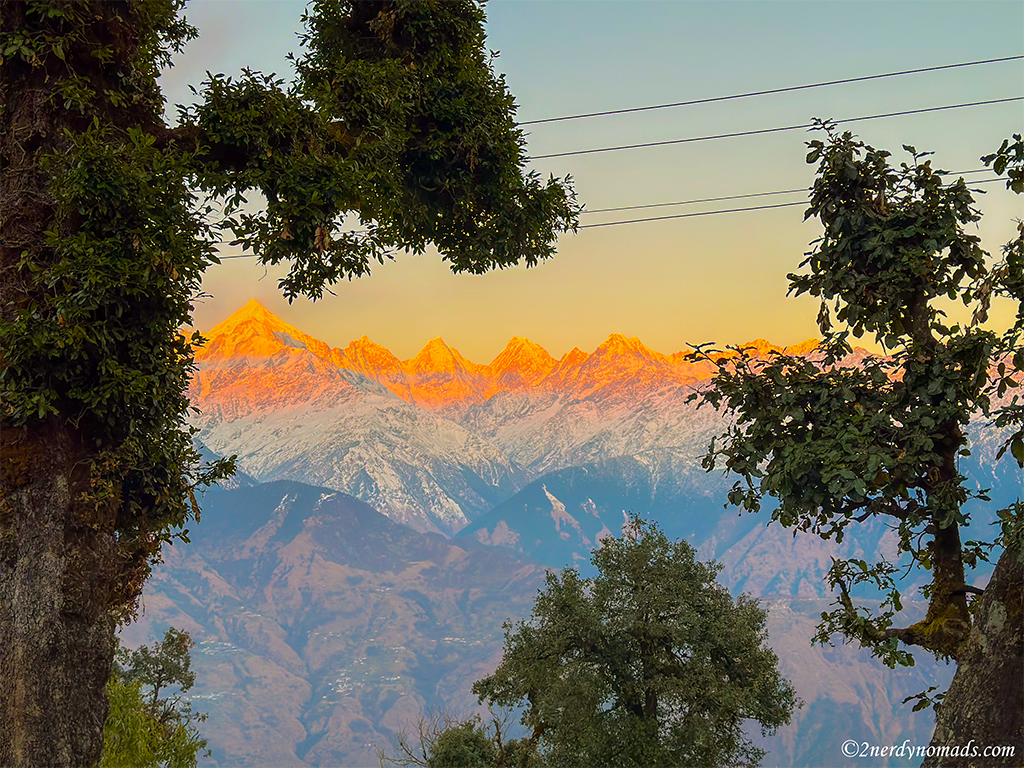
- Save
Have you been to Munsiyari or planning a trip soon? Let us know your thoughts, questions, or experiences in the comments below – we’d love to hear from you!




Very detailed itinerary, gud job!keep going 👍🏻
Hi Annu,
Thanks for your kind words:-) Have a nice trip to Munsiyari😊
Hi
Thanks for sharing your information n experience of scinic beauty place
Hi Ashish,
So glad you liked it! Munsiyari’s beauty deserves all the love.😊
Nicely explained the beauty and guide of this place
Hi Narendra,
So glad you liked it! It’s one of our favorite town in Uttarakhand😊.I hope it inspires you to plan a trip soon!
Very nyc detailed itenary
Hi Neha,
Thankyou so much! Have a nice trip to Munsiyari😊
Very good and detailed itinerary. Lots of helpful information.
Just one question how is the weather of June as in is it safe to go there at this time considering rains ?
Hi Pallak,
April to June is perfect if you enjoy sunshine and lush greenery. Although its dry season, but its best to check with your hotel about weather prior to your visit and plan accordingly. Safe Travels 😊
Thanks for sharing this detailed and informative post. Really helpful ❤️
Hi Lavish,
So glad it helped 😊